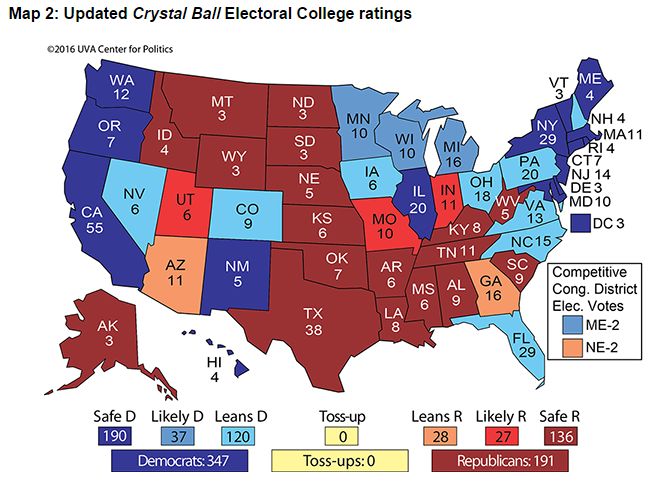Three months ago, the University of Virginia’s Center for Politics projected the results of the presidential vote in 2016. Using Donald Trump and Hillary Clinton as the expected nominees -- and citing all the requisite caveats about timing and assumptions -- the analysis showed Democrat Hillary Clinton taking 347 electoral votes to Trump’s 191.
On Thursday, the Center for Politics issued an updated map, and virtually nothing has changed. Nothing, that is, except that three months have passed and Trump has not been able to make a serious dent in Clinton’s apparent lead.
Related: Trump Goes All In, Forgives $50 Million in Campaign Loans
The current projections don’t posit a Johnson v. Goldwater blowout. It’s not even an Obama v. McCain blowout. But if the analysis by center director Larry J. Sabato, Kyle Kondik and Geoffrey Skelley is even close to accurate, it suggest that the Republican Party could be facing a major defeat in November unless things turn around quickly.
“Currently, we show every Obama 2012 state at least leaning to Clinton, along with North Carolina, the one state won by Mitt Romney where we currently see a Democratic edge,” they write. “Obama carried North Carolina in 2008 along with Indiana, a traditionally conservative state that has long been the most Republican state in the Midwest. If Clinton’s national lead does grow further, it’s far from impossible that she might be able to carry Indiana, as well as Missouri, which Obama did not carry in either of his elections. But as of now, we think that is unlikely, and Trump remains the favorite in both.”
For purposes of this particular exercise, all 50 states and the District of Columbia are placed into either the Democratic or Republican column and classified on a scale that goes from “Leans” to “Likely” to “Safe.” There are no “Toss-up” states at this time.
In its latest iteration, the map adjusts only a few state ratings, mostly in favor of Clinton. Arizona and Georgia move from Likely Republican to Leans Republican, while Utah moves from Safe Republican to Likely Republican.
Related: Trump’s Biggest Gift to Clinton -- Choosing the VP She Really Wants
Interestingly, the authors detect a slight pro-Trump movement in Pennsylvania, which goes from Likely Democratic to Leans Democratic.
“If Trump’s blue-collar strategy is going to work, the Keystone State is a logical target,” they write. “But it’s an open question how many more votes a Republican can add to the party’s net tally in areas such as southwestern Pennsylvania, considering the edge the party has there already. In addition, Trump will also have to overcome what should be at least a 400,000-vote Democratic plurality just from Philadelphia County, not to mention challenges in the big, wealthy, well-educated suburban counties that ring the city.”
The bottom line, according to Sabato and company, is that Trump still has a path to victory. But it hasn’t gotten any shorter in the past three months, and his time to navigate it has.






